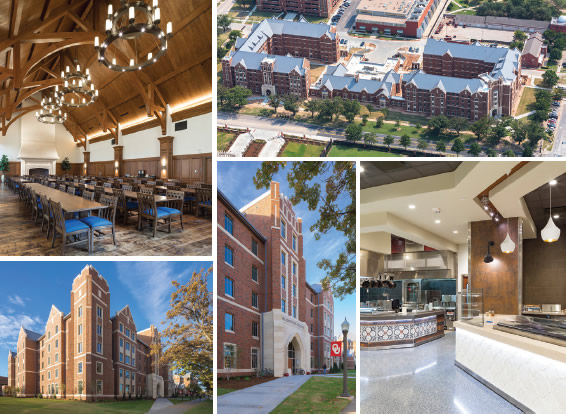University of Oklahoma: Headington and Dunham Residential Colleges

PHOTOS © DAVID COBB PHOTOGRAPHY
Utilizing the “residential college” community model, student housing design experts KWK Architects of Webster Groves, MO, with architect-of-record ADG Architects of Oklahoma City, OK, designed the first residential colleges in Oklahoma at the University of Oklahoma in Norman. A dedication ceremony for the new Headington and Dunham residential colleges was held on October 11, 2017.
The new $75 million residential colleges are designed as living/learning spaces that provide upperclassmen with a sense of community and identity within the larger university environment, by combining three different aspects of student life: living, learning, and community fellowship. The goal of this model is to engage students within the residential colleges beyond their freshman and sophomore years to create lasting relationships and a sense of identity.
The facilities, located south of the football stadium at the southwest corner of Jenkins Avenue and Lindsey Street, opened in fall 2017 with 300 students in each building.
Taking cues from residential colleges on Ivy League campuses such as Harvard, Yale, Oxford, and Cambridge, each building features a faculty master apartment and office, dormitories, private parking, seminar/conference rooms, lounges, study areas, libraries, and dining rooms. The two residential colleges are also connected by a communal dining area and storm shelter, and each boasts a house motto, colors, crest, and athletic teams. The architectural design of each college was influenced by the Cherokee Gothic style featured on several buildings throughout the campus.
The project team, which included KWK Architects, ADG Architects, and Brailsford & Dunlavey program management, began the project by first creating a master plan for expanding student campus housing at the university. The team reviewed existing housing facilities, as well as available campus sites and near-campus housing, before surveying students to determine optimal rental prices, unit sizes, room configurations, and desired amenities for the new residential colleges.
This article originally appeared in the College Planning & Management January 2018 issue of Spaces4Learning.